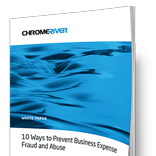$2.8 billion is a hefty chunk of change. It’s also the estimated amount of money business lose due to employee expense report fraud in the U.S. alone. Losing money isn’t the only hit businesses can suffer. Companies can become subject to audits, lost investor confidence and end up with the potentially public embarrassment of having to fire employees and managers engaging in or allowing fraudulent activities.
Related : PayStream Advisors’ Webinar: Expense Fraud – What Were They Thinking?
The first step in preventing expense abuse and fraud is to understand how and why it happens. The how typically falls into one of two categories:
- Deliberately submitting fraudulent expenses
- Inflating or manipulating legitimate expenses
Deliberately Submitting Fraudulent Expenses
In the case of outright, deliberate fraud, employees may submit expenses for any number of items, miles not traveled – or anything else they feel they can sneak by your expense report review team. Here you may find the submission of:
- Food, gas or other personal items listed as business expenses
- Expenses for items that were never used, such as cancelled airline tickets or registration fees for conferences the employee didn’t attend and subsequently had refunded
- Any number of receipt-less expenses conveniently below the company’s threshold for needing a receipt
- Mileage reports for trips in which the employee was a passenger
- Falsified or manipulated receipts
Employees may also be colluding with a supervisor or subordinate to cast a blind eye to false or excessive expenses. With 1.1 million American workers admitting to deliberately falsifying expense reports, there’s a large pool of people that could be playing in the expense fraud game.
Inflating or Manipulating Legitimate Expenses
While deliberate expense fraud attempts to pass off a fraudulent expense as a valid one, expense abuse attempts to inflate or manipulate a legitimate expense. This category can include instances like:
- Booking a higher class of travel, such as limo rides of business-class flights, when less expensive alternatives are available
- Submitting meal and entertainment expenses that are far above policy amounts, or trying to sneak in items that are not allowed, such as sports tickets or alcoholic drinks
- Adding tips for meals, taxi rides or other expenses where tips are already included in the cost
- Inflating the amount tipped, such as submitting an expense for a 20 percent tip when the employee actually left a 10 percent tip
- Submitting higher than actual mileage totals for trips taken in personal vehicles
Why Expense Fraud Happens
Now that you know how expense fraud can happen, it’s time to learn why. Some employees may simply not be aware of expense policies and believe they are submitting legitimate expenses. Others may feel as if they’re not being compensated enough for the work they do, and padding their expenses can be a way to make up the difference, or believe that they are “owed” by the organization, for example for traveling over weekends. Still others may find the company expense policy too strict, using fraud as a way to retaliate.
Also, many employees may think that the amount of fraudulent expenses may be relatively trivial, for example just adding 20 miles to a journey. While few will do so as part of a concerted and prolonged effort to defraud, for organizations with large workforces, these losses could still run to millions of dollars per year.
How to Stop It
Stopping expense fraud in your company is possible, especially if you follow a few suggestions. The first is to review your expense policy to ensure it’s not unworkably complex or strict and prone to rebellion. Ensure that employees are aware of the regulations, as well as the impact of attempting to defraud the organization. For many, the fear of being caught and knowledge that it could lead to serious repercussions may be enough to eliminate fraud.
The second is to implement preventative measures to both limit the potential for fraudulent expenses to be submitted, in addition to putting tools in place to spot expense abuse. In particular, organizations that continue to use spreadsheets or antiquated first-generation expense solutions should look to invest in a global expense management solution. These solutions are armed with fraud-stopping features, such as real-time expense automation, policy parameters built right into the system, and other safeguards that protect your company.
The third is to learn even more about expense fraud, something you can achieve by downloading our white paper 10 Ways to Prevent Business Expense Fraud. No matter how widespread or financially devastating business expense fraud may be, it doesn’t have to happen in your company’s own backyard.
Search
Subscribe
Latest Posts
- Driving AP Success With Automation Part 3: How to Save Time and Money While Increasing Compliance
- Driving AP Success With Automation Part 2: How to Create More Efficient Processes With AP Automation
- VAT IT Partners With Emburse to Help Companies Save 27% on Expenses
- Driving Success With Automation Part 1: 4 Common AP Management Bottlenecks
- The Future of Finance: 5 Predictions For Digital Transformation in 2022 And Beyond
Posts by Category
Our choice of Chrome River EXPENSE was made in part due to the very user-friendly interface, easy configurability, and the clear commitment to impactful customer service – all aspects in which Chrome River was the clear winner. While Chrome River is not as large as some of the other vendors we considered, we found that to be a benefit and our due diligence showed that it could support us as well as any large players in the space, along with a personalized level of customer care.
We are excited to be able to enforce much more stringent compliance to our expense guidelines and significantly enhance our expense reporting and analytics. By automating these processes, we will be able to free up AP time formerly spent on manual administrative tasks, and enhance the role by being much more strategic.
